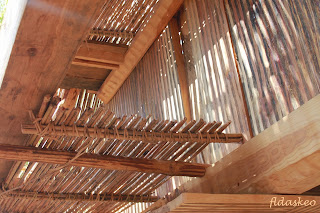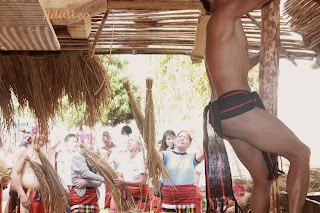Binangi:
A past reconstructed
By: Felomina Lisweg- Daskeo
Long before our ancestors
heard of nails and concrete, they were able to construct sturdy houses that
could withstand the strongest typhoons with whatever available materials that
they could find in the forest, like sticks, lumber, cogon grass and vines.
These houses were called “binangi”, others call it gina-on, binatang, or
inatep. Such were the houses that dotted our mountainsides as found by the
Spanish conquistadores. However, only a few of these houses have withstood the
ravages of time and the elements, and the remaining ones are already in an
advanced state of deterioration.
As part of the celebration
of the annual “Ayyoweng di Lambak ed Tadian” then, the municipal government
decided to construct a binangi “as a way of valuing our past,” according to Tadian
Mayor Anthony Wooden. Indeed, it is but a fitting tribute to a people who have endured
and maintained their cultural identity through decades of colonial rule. It is
saddening to note though that this so-called cultural identity is already
getting frayed and as the years pass by, the ties that bind us to our past are
getting cut one thread at a time.
We cannot transcend time and
go back to the past; we can only reminisce, listen to our elders’ glorious
stories, and learn to understand where we came from so that we will not get
lost in the present and be able to stay focused in the future. The reconstruction then of the binangi –
which was done as close to the original as possible- is more than just a simple
replication for nostalgia’s sake, but was meant to educate our generation about
this simple structure that embodies a lot of the values and character that
defined who we are as Igorots particularly of Western Mountain Province.
In the next few years, the
binangi at the Tadian municipal grounds might be the last that this generation
will see, but it was constructed with the objective that the remaining binangis
around the municipality will be preserved if the children will come to
understand the indigenous knowledge, systems and practices underlying the
building of one. It was only when I took part in the construction of Tadian’s
binangi last February 25 that I fully came to understand what the saying “It
takes a village to educate a child” means.
Building a house in olden
times is a collective effort, so it also takes a village to put up a house. Since
everybody in the community is involved, the house and its inhabitants also become
the community’s responsibility. You cannot steal from what you own, thus houses
were not locked, yet nobody complains of robbery or theft. Materials came from
what is available in the forest, so environmental sustainability is emphasized.
Nature will provide for our needs, in turn, we also need to protect it. Each
becomes his/ her neighbor’s keeper, thus, even the upbringing of the children
is not the sole responsibility of the parents.
These are but some of the
lessons that we teachers- duty- bearers of Indigenous People’s Education- can
impart to our children. As the Mayor said, it was put up for educational
purposes, and to preserve the knowledge about building a binangi since the
keepers of the knowledge are about to kick the dust. It is a noble effort to
bridge some of the broken intergenerational ties caused by our “miseducation”.
By bridging these gaps, we might again be able revive the spirit of the tribe
to guide us as we dig deeper to stay rooted in our cultural identity and still
be able to meet head on the challenges of globalization.
|
It takes a
village to build a house. Representatives from the different barangays
of Tadian and other line agencies came together for the “sukgot” or the
roofing of the binangi. Photo by Felomina
Daskeo
|
|
|









































































































